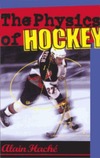What do Wayne Gretzky and thermodynamics have in common? A lot more than you might think. The game the National Hockey League calls " the coolest game on earth" is also a fast-paced, dynamic display of physics in action.
In The Physics of Hockey, physicist and amateur hockey player Alain Hach? examines some of the physical principles behind the world's most popular winter team sport. What makes ice so slippery you can skate on it? How can you skate backwards most rapidly? How can physics improve your slapshot? Why do some collisions cause injuries but not others? How does a Zamboni work? And how do you prepare a pure, smooth ice surface in Dallas when it's 90 degrees outside and there are twenty thousand people inside?
This is physics by a hockey fan for the hockey fan. Hach? investigates the properties of the ice surface, the science of skating and of skates, the odds of winning and losing streaks, and the principles behind shooting, hitting, and goaltending. Touching on topics such as solid-state physics, statistical physics elasticity, probability, thermodynamics, and mechanics, Hach? uses science to enhance our appreciation and understanding of the game. The book is illustrated with photos and graphs and punctuated with anecdotes to show how famous players, past and present, are really physicists on skates.
A thought-provoking, fun, and gentle introduction to some basic issues in physics, The Physics of Hockey is a truly unique book worthy of the shelf of every hockey fan and physics enthusiast.
 |
|
О проекте
|
|
О проекте


